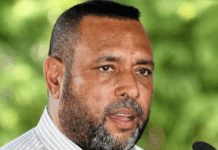A report on innovative solar energy technology for the Pacific. Video: NZIPR
By Sri Krishnamurthi with Peter Wilson in Auckland
Solar-powered batteries are the key to a future without electricity grids for Polynesian countries in the Pacific (Samoa, Cook Islands and Tonga), a study has found.
The study is funded by the New Zealand Institute for Pacific Research (NZIPR) to assess the feasibility of a low-cost, energy future – titled “Polynesian pathways to a future without electricity grids”.
The first phase of the research, conducted by Peter Wilson (principal economist and head of Auckland business for the NZ Institute of Economic Research) and his team of Professor Basil Sharp (Auckland University professor and chair in energy economics) and Gareth William (head of Solar City Energy Services), queries whether distributed solar electricity is a practical alternative to grid-based electricity.
“The project is investigating the impact of new technologies on electricity sectors in the Pacific, we are looking at whether solar panels and batteries could augment or eventually replace electricity grids and large diesel generators,” says principal investigator Wilson.
“First phase is showing that the costs of both solar panels and batteries is diminishing very quickly and it won’t be very long before they will be economic in the Pacific and so that you have the potential to start radically changing how energy is delivered to Pacific nations.”
While he believes it is technologically feasible now, the prohibitive cost of the batteries at the moment – the leading provider of solar batteries being Elon Musk’s Tesla Powerwall – is something that has economically got to arrive yet, but the trend is towards costs being reduced significantly.
He says that within 10 years batteries and solar panels together could have a large impact on existing electricity sectors in the islands, and he sees that as a positive development because it will make it easier to extend electricity to people who don not currently have it at a cheap cost.
Decisions needed
However, he says, it does mean that the island governments must consider what they do with their existing generators and existing distribution assets if they are found to be non-competitive against the new technology.
“While it is not economically feasible yet, the trends are there and so it’s something that the Pacific governments should start thinking about,” says Wilson.
“At the moment they’re focusing very much on using solar panels to replace their electricity generation, they’re just connecting to their existing electricity grids and existing technologies.
“We think the batteries are going to change the equation and that is something that should be looked at, and the point is that this is not just something for the Pacific Islands, it’s happening around the world and a lot of countries and a lot of companies are trying to work out what to do, but they don’t really have a solution.”
He is expecting exciting new technological developments in batteries as a means of storing electricity into the future.
“The basic technology is not changing. What is changing is the cost of the batteries and their efficiency, how much power they can hold,” says Wilson.
“We’ve all seen how cell phones have become smaller and smaller over the few last years, and a large amount of that is because the batteries getting smaller and better, electric vehicles are doing the same thing. It is the same technology just using it for a different purpose.”
Hawai’ian benchmark
Hawai’i is an example they studied because it is like the South Pacific countries.
“Hawai’i which has a similar geography to the South Pacific, it’s North Pacific and tropical country with small islands and they too have moved to replace the diesel-fired generators with solar panels,” says Wilson.
“That’s a good benchmark to look at on the technological side but the economics are slightly different because it’s bigger Island, but what we particularly looked is that is an example of what could happen.”
The next phase is due to begin as soon as the NZIPR give it the greenlight.
Peter Wilson explains the way forward. “Hopefully it starts sometime this year and that involves going out to the islands and doing on-the-spot investigations, talking to people, at the moment phase one was desk research based in New Zealand.”
“So far the Ministry of Foreign Affairs and Trade (MFAT) has been very supportive of the project They’ve been funding quite large numbers of solar panels into the Pacific and they are quite keen to look at this next development which is adding batteries to that investment.”
He says the electricity generation industries are facing a major change in the evolution of the technology with what they do in their business.
‘Technological revolution’
“These industries are facing a technological revolution. They have choices, how do they respond? do they try to get ahead the curve, do they bury head in sand, do they try and make it someone else’s problem.
“We are seeing around the world this issue is being addressed, in some countries, some companies are very supportive and wanting to get to get on the bandwagon.”
Ultimately the goal is renewable energy to expand access to affordable, reliable and clean energy in the Pacific. Renewable energy targets feature prominently in all their Nationally Determined Contributions submitted under the Paris Agreement on climate change.
Already a change is underway in Australia and New Zealand with a slow but sure transformation to renewable energy.
“It’s starting to change now. You are seeing in Auckland the lines company Vector is starting to invest in large batteries (Tesla Powerwall batteries) rather than just look at extensions to the grid.
This is a project that can change the economies of scale of Pacific countries and Peter Wilson is banking on it to transform lives in Samoa, Cook Islands and Tonga.
The Pacific Media Centre shares content with the NZ Institute for Pacific Research as part of a collaboration agreement. The video was edited by Blessen Tom as part of the partnership.














































[…] Source: https://asiapacificreport.nz/2018/11/09/low-cost-solar-batteries-key-to-cheap-electricity-for-polyne… […]
Comments are closed.